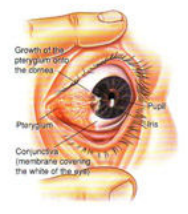Pterygium
What is a Pterygium?
A Pterygium is a benign or non-cancerous overgrowth of the conjunctiva. It can appear as a wedge-shaped growth of thickened tissue that covers the white part of the eye.
It starts on the conjunctiva of the eye (the thin layer that covers the white part of the eye or sclera) and can spread to the cornea.
A Pterygium may occur in one or both eyes.
What is the Impact of a Pterygium?
A Pterygium may cause eye discomfort including:
- A burning sensation,
- Irritation,
- Redness,
- Tearing,
- Foreign body sensation, and
- Blurred vision due to distortion of the shape of the cornea (astigmatism).
If the growth becomes large enough, it may begin to inhibit vision.
What Can Cause Pterygium?
A Pterygium is usually the result of long-term UV (ultraviolet) light exposure from the sun. They occur more often in people who spend a lot of time outdoors, especially near the water due to the added reflection of the sun's rays. Other contributing factors include smoke, dust and other irritants.
A Pterygium typically starts growing near the inside of the corner of the eye. It often extends onto the cornea, towards the pupil. Both eyes can be affected. A Pterygium may grow large enough to interfere with sight and can cause other annoying symptoms. If it is not causing many symptoms, it can safely be left alone.
Pterygium Assessment
Your ophthalmic surgeon will perform a comprehensive eye examination in order to diagnose and assess the severity of the Pterygium.
Your treatment depends on the size and extent of the Pterygium. When there is a rapid growth of the Pterygium or where vision is threatened, your ophthalmologist may recommend surgical removal of the pterygium, even if you have minimal symptoms.
What is the Best Treatment for Pterygium?
Treatments include sun protection with regular use of wrap-around sunglasses and a wide-brim hat, to reduce UV exposure and minimise any further growth of the pterygium. Sometimes eye drops are required for symptomatic relief, however this will not cure the pterygium.
Surgical treatment is performed at day surgery.
The latest advancement in Pterygium surgery is “Pterygium Excision and Conjunctival Autograft”. During this procedure:
- the Pterygium is excised,
- The gap in the conjunctiva left by the removal of the Pterygium is filled with a conjunctival tissue graft. (transplant from the conjunctiva underneath the upper eyelid). This graft is held in place with the use of very fine sutures or a special glue.
- The graft acts as a barrier to recurrence, however, there is still a 5% chance of recurrence despite a perfect graft placement. (Without the graft, the chance of recurrence is 80%).
Reasons for Pterygium Surgery
Surgery for Pterygium may be required if
- Your normal vision is affected,
- You have irritation, tearing and discomfort,
- You develop or increase astigmatic error (glasses correction),
- You have redness in appearance,
- You are having difficulty wearing Contact lenses
- You are due to have cataract surgery and need the pterygium removed first
More about
Pterygium Surgery




